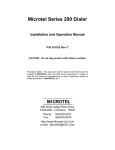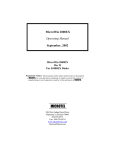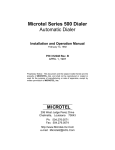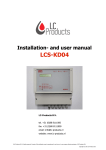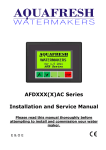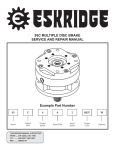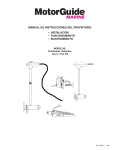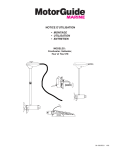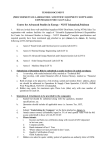Download Microtel 100 Dialer Series Specifications
Transcript
Microtel Series 100 Dialer Installation and Operation Manual P/N 310161 Rev B CAUTION: Do not ship product with battery installed. Proprietary Notice: This document and the subject matter hereto are the property of MICROTEL, Inc. and shall not be reproduced or copied or used for the purpose of manufacturing or sale of apparatus, except by written permission of MICROTEL, Inc. MICROTEL 206 West Judge Perez Drive Chalmette, Louisiana 70043 Phone: Fax: 504/276-0571 504/276-0574 http://www.Microtel-Inc.Com e-mail: [email protected] ii MSC-100 INSTALLATION AND OPERATION MANUAL TABLE OF CONTENTS PAGE I. Introduction A. General Information.................................................................................... 1 B. Unpacking and Incoming Inspection........................................................... 2 C. Physical System Installation.................................................................…... 3 D. Battery Installation....................................................................................... 4 E. Electrical Power Installation....................................................……………. 5 F. Telephone Line Installation......................................................................... 6 G. Fault Monitoring Interface Connections................................………………. 7 H. Powering Up the System............................................................................. 8 II. Programming the Dialer System A. Station Identification.......................................................………………….. 9 B. Fault Delay Time Programming…....................................………………….. 9 C. Telephone Numbers.................................................................................. 10 D. Operational Parameters .................................…………………………….. 10 1. Setting The Ring Count.....……….............................................…...... 10 2. Tone or Pulse Dial Selection..........................................................…. 11 3. Message Repetitions.......................................................................... 11 4. Intercall Delay..................................................................................... 11 5. Access Code…………….............................................................….... 11 III. Operations A. System Familiarization and Key Function Summary................................. 13 B. Putting the Unit in Run....……................................................................... 15 C. Receiving an Alarm................................................................................... 15 D. Remote Control Functions………………................................................... 16 E. Test and Advanced Keystroke Sequences............................................... 17 Maintenance and Troubleshooting A. Maintenance……………............................................................................ 18 B. System Specifications............................................................................... 19 C. Product Warranty................................................................................…... 20 D. Vocabulary List…...................................................................................... 21 E. Vocabulary List Oil and Gas Industry........................................................ 22 F. Potentiometer Map……………………….................................................... 23 G. Vocabulary List Oil and Gas Industry........................................................ 24 IV. iii iv I. A. INTRODUCTION GENERAL INFORMATION The purpose of this manual is to completely explain the function, installation, and operation of the MCS Model 100. Communication System. This automatic dialing, synthesized speech, telephone based monitoring system represents a new generation of computer controlled telemetry devices, packed with features and capabilities not to be found in any other telephone oriented monitoring system. The device is designed specifically for industrial based equipment monitoring needs, by the engineering staff, which invented the concept of synthesized speech dialers. The MCS (Microtel Communication System) is configured to accept eight channels of normally open or normally closed fault state switches (contacts), such as float switches, pressure switches, temperature switches and similar devices that contain an unpowered contact that changes state whenever a preset condition is violated. Fault recognition can be set as fast as 1 second or as long as sixty seconds. Internally, the system monitors its own power supply and will respond to any power outage which lasts longer than one minute. When an alarm occurs, recognized by the system as the opening or closing of an external contact, it begins to place a series of telephone calls, dialing up to eight different telephone numbers, one at a time, in an attempt to make contact with a qualified person to whom it can deliver a synthesized verbal message, describing the alarm condition. This message can be programmed by the user to consist of virtually any string of individual words in response to any fault condition. The system contains a "core" vocabulary of sixty five words, and an "application" vocabulary comprised of a minimum of thirty two words selected for the particular application that the unit is to be used In. The system will continue to call from the list of up to 8 numbers, insisting that its message be heard. Also, if desired, the system can be called at any time to check or verify the monitored conditions. When on line with the system, telephone numbers can be changed, delays can be changed, the system can be placed in the halt mode or put back in run--the system can even be instructed to place a test call back to any location just to be sure it can get through the telephone network when it needs to. Recognizing that telephone based remote monitoring systems such as this have typically have to share a telephone line with a telephone, the system contains a built in speakerphone and can be placed in an unattended intercom mode for "listening in" to the monitored location. These instructions generally describe the installation, operation and maintenance of the equipment. Microtel reserves the right to make engineering refinements that may not be described herein. Any questions arising that may not be answered herein should be directed to Microtel directly or one of our authorized sales agent for a prompt response. 1 B. UNPACKING AND INCOMING INSPECTION Microtel takes all possible precautions in packaging each item to prevent shipping damage. Carefully inspect each package at the time of receipt for signs of physical damage. Report damage claims to the shipping agent involved immediately. Do not install damaged equipment. All instructions given on any attached labels or tags should be followed. Carefully inspect all packing material before discarding it to prevent the loss of accessories, mounting hardware, spare parts, or instructions. If the unit is not to be installed immediately, repack it in the shipping carton to protect it in storage. 2 C. PHYSICAL SYSTEM INSTALLATION Mount the system on a wall or other vertical surface, away from and protected from harsh weather extremes. It is also recommended that the unit not be placed in close proximity to high voltage (480 V and higher) electrical equipment. Four mounting holes on the left and right side enclosure flanges are to be used for system mounting. It is recommended that the system be mounted approximately 5 feet above surface grade for proper microphone reception in both the speakerphone and intercom mode. There are three access holes on the bottom of the unit. The left side port is for power connection to 120 vac. The middle port is for the system's telephone line connection, and the right side port is intended to be used for the entry of fault monitoring channel conductors. There is an additional hole in the bottom of the unit, into which the speakerphone microphone is mounted. The following figure shows the recommended dimensions to be used in the physical Installation of the system. 3 D. BATTERY INSTALLATION The battery installs at the top of the system, in the battery tray provided as part of the interior chassis assembly. It is necessary to remove power from the system if it is currently applied. REMOVE 120 VAC POWER FROM THE SYSTEM IF YOU HAVE NOT ALREADY DONE SO Open the system front panel and retrieve the red and black battery leads from within the battery tray. Push the battery lead terminals on to the new battery, BEING CERTAIN that the red lead connects to the positive (+) battery terminal, and the black lead connects to the negative (-) battery terminal. Slide (do not force) the battery completely into the battery tray with the TERMINALS POINTED INTO THE SYSTEM. If the battery is not completely seated in the battery tray, the front panel will be obstructed and will not completely close. A new battery will take no longer than 24 hours to gain a full charge, capable of powering the system through any power outage up to four hours in length. It should be noted that the LOW BATTERY indicator is only valid when the 120 vac power is on. If the LOW BATTERY indicator stays on for more than eight hours, the battery is in need of replacement. 4 E. ELECTRICAL POWER INSTALLATION Electrical power may be applied by simply plugging the system into a grounded, three wire outlet. BE CERTAIN THAT THE OUTLET HAS AN ADEQUATE EARTH GROUND. INSUFFICIENT EARTH GROUND CONNECTIONS CAN HARM THE UNIT AND PREVENT INTERNAL PROTECTION CIRCUITRY FROM PERFORMING PROPERLY. It is recommended that a separate circuit breaker be used with the system. Remember that when the breaker is on, and the unit is plugged in, 120vac is contained within the system even though the internal STANDBY/OPERATE switch may be turned off. If the unit is to be installed in a location where large or high voltage motors are in use a power line transient suppressor is recommended to insure that the unit is not affected by surges and spikes in the 120VAC power to the unit. If such a device is needed, contact Microtel for assistance. The internal system fuse is a 1/4 amp fuse (Littlefuse #312.250), or equivalent. WHEN INSPECTING OR REPLACING THE FUSE, YOU MUST UNPLUG THE SYSTEM OR THROW THE CIRCUIT BREAKER SUPPLYING POWER TO THE UNIT. 5 F. TELEPHONE LINE INSTALLATION The connection to the telephone network is a matter of simply plugging the modular Jack cable into the telephone line termination provided by the telephone utility (RJ11C or equivalent). This section contains important information regarding the installation of the telephone line to be used by the system, and pertinent information for notifying the telephone company of what type of line is to be installed. The MCS is registered for direct connection to the telephone network by the FCC, which places three restrictions on its use: 1. The system cannot connect to a party line or a pay telephone line. 2. The telephone company must be notified that an FCC registered device is being installed. 3. If trouble is experienced with the device, it must be immediately disconnected from the telephone network. Microtel must make any repairs, which may be necessary in order to maintain the FCC registration status of the device. THE FOLLOWING INFORMATION WILL BE REQUIRED BY THE TELEPHONE UTILITY WHICH INSTALLS THE TELEPHONE LINE FOR THE SYSTEM: 1. The FCC Registration Number, which is, D4J6M6-13598-AL-E. 2. The Ringer Equivalence, which is 0.2B. 3. The system needs to be connected to an RJ-11C telephone jack. 6 G. FAULT MONITORING INTERFACE CONNECTIONS The MCS system is designed to accept up to eight channels of dry (unpowered), normally open or normally closed signal lines. The system provides a small sampling current to determine if the contact is open or closed. Leads from normally open or normally closed switches may be routed through the conduit port at the lower right side of the system. Connect each wire pair to its appropriate channel input terminal pair on the Fault Interface Assembly card. Shielded, twisted pair, F20 or F22 wire (Belden 8205 or equivalent) is recommended. If shielded cable is used, ground the shield at the sensor and leave the shield floating (unconnected) at the MCS system. Each channel must be configured to be either normally open or normally closed. A channel should be normally open if the "no fault" condition is that condition which consists of an open circuit on that channel's wire pair. A channel is normally closed if the "no fault" condition is that condition which consists of an closed circuit on that channel's wire pair. An eight-position DIPswitch is provided to set the state of each channel to a normally open or normally closed configuration. When the switch associated with a channel is in the OPEN or OFF position, that channel is configured as a normally closed channel i.e., a closed fault switch is a no fault condition. When the switch associated with a channel is in the CLOSED or ON position, that channel is configured as a normally open channel i.e., an open fault switch is a no fault condition. For each channel, as indicated on the Fault Interface Assembly card, program the switch associated with that channel to the desired state. Adjustable potentiometer R35, located on the opposite end of the fault interface card from the DIP selector switch, labeled Fault Integrate, controls the length of time it takes for the system to recognize a fault condition, regardless of whether it is configured as a normally closed or normally open channel. The time may be user set for one second minimum to one minute maximum. The relative timing may be viewed by watching the indicator CR13. The actual integration time is four times the flashing rate of CR13. Any unused channels should be programmed a normally open, and left unconnected. . 7 H. POWERING UP THE SYSTEM NOTE: IF THE UNIT ABOUT TO BE POWERED UP FOR THE FIRST TIME CONTAINS HARDWARE FOR OPTIONAL FEATURES, READ THE SUPPLEMENTARY INSTRUCTION MANUAL FOR THOSE FEATURES BEFORE POWERING THE UNIT UP FOR THE FIRST TIME. After the system has been mounted in a suitable area, the battery installed and power, telephone and fault sensing lines connected, it may be powered up by switching the "STANDBY - OPERATE" switch in the OPERATE position. This switch is on the main printed circuit board inside the chassis and can be found by opening the front panel of the metal chassis. When the unit is powered up, the front panel indicators will flash in sequence for a few moments and the system will then say "system ready". If this does not happen, turn the switch to the STANDBY position and disconnect power and the telephone line from the unit. Contact qualified service personnel or Microtel for instructions or repair. 8 II. PROGRAMMING THE DIALER SYSTEM For this section, be advised that the keystroke entries are CAPITALIZED and the system's response whether visual or audible, is enclosed with in [brackets]. The system must be in the Halt mode to accept programming Information. If it is not in the Halt mode, depress the HALT key to force that condition. ["system ready"] A. STATION IDENTIFICATION There are two ways to enter a station identification message into the system. The station can be identified as a number up to eight digits in length, in which case the system will refer to itself as, "this is station XX...X". Alternatively, the system will allow the entry of up to sixteen words from either the "core" vocabulary, the "application" vocabulary, or both, to be connected together into one identification message. For instance, the station identification "This is the east plant" is comprised of five words from the system's vocabulary. The first case is called the Number Mode, while the later is referred to as the Message Mode of station identification entry. * Number Mode Entry of Station Identification 1. ENTER, 0 ["station number, ready"] 2. Enter desired digits, terminate the entire entry with a second depression of ENTER ["the station number is xx...x"] To read this data, READ,0 ["the station number is xx...x"] * Message Mode Entry of Station Identification 1. ENTER, MESSAGE,0 ["station identification, ready"] 2. Enter desired words by entering the appropriate three digit codes for each word in sequence from the core or application vocabulary lists found in the appendix 3. Terminate the entry sequence with a second depression of ENTER ["the station identification is ...(word1), (word2), (word3)...(word 16)"] To read this data, READ, MESSAGE, 0 ["the station identification is ...(word1), (word2), (word3)...(word 16)"] B. FAULT DELAY TIME PROGRAMMING The system allows the user to program sentences up to eight words in length to be spoken by the system identifying each fault condition. The unit is shipped with nonspecific phrases already programmed in. The system will articulate the channels as "fault 1, fault 2.... fault 8". The programming example below illustrates the message string programming for channel number 1. This programming operation may be used for all channels, which are to be used by the system, or the pre-programmed phrases may be used for any or all of the messages. The following example illustrates the programming procedure for fault channel 1: 9 1. ENTER, MESSAGE, 1 ["message 1, ready"] 2. Enter the desired three digit word addresses from core or application vocabulary lists found in the appendix (each word selected will be spoken by the unit following its three digit entry). 3. Terminate entry sequence with a second depression of ENTER To read this data, READ, MESSAGE, 1 ["message 1 is... (word1), (word2),(word3)...(word s"] Status only Channel Programming Any fault channel may be programmed as a "status only" channel (i.e. it will not cause call-outs to begin, but will be reported in any status messages). To program a channel as a "status only" channel, program the word "tone" from the core vocabulary list as the first word in the fault message for that channel. The unit will make a "beep" sound after the 3-digit code for "tone" is entered. The remaining seven words identifying that channel may then be entered as in the examples above. C. TELEPHONE NUMBERS The system can be programmed with up to eight telephone numbers, which will be called sequentially when an abnormal condition is detected by the system on any fault channel not programmed as a "status only" channel. The example below illustrates the telephone number programming procedure for telephone number 1. This programming operation may be performed for all telephone number positions, which are to be used by the system. 1. ENTER,1 ["telephone number 1, ready"] 2. Enter the desired phone number by depressing the numbers on the keypad. The unit will repeat each number as you depress it. 3. Terminate the entry with a second depression of ENTER ["telephone number 1 is nnn...n"] To read this data, READ, 1 ["telephone number 1 is ...nnn...n"] Up to 16 digits may be entered for each phone number position. If any of the numbers the unit is to call require a pause for a second dial tone, enter the pause by using the DELAY key in place of a numeral. To clear a phone number out of the unit, enter a 0 (zero) as the phone number. The unit ignores any phone number that starts with a 0. If you wish to have the unit call the Operator, enter the phone number as DELAY, 0. D. OPERATIONAL PARAMETERS This section describes the procedure for setting 5 operational parameters. The first two parameters require the setting of an option switch (DIP switch) on the inside of the unit. This switch is on the middle of the right hand edge of the main printed circuit board, as illustrated on the figure below. 1. Setting the Ring Count 10 The ring count is the number of rings the unit will wait before answering a call placed to it. This may be set to either 2 rings or to 8 rings. Perform this selection by setting position 1 on the option switch to the OPEN (or "off") position for 2 rings and the CLOSED (or "on") position for 8 ring selection. 2. Tone or Pulse Dial selection The system needs to be set for pulse or tone type dialing. Perform this selection by setting position 2 on the option switch in the OPEN (or "off") position for tone dialing, and the CLOSED (or "on") position for pulse type dialing. Before utilizing the tone dialing mode, confirm with the telephone company that services the installation that the line the unit is connected to will accept tone dialing. 3. Message Repetitions The system will repeat its fault status message a number of times in the course of any telephone call which it places. The system is shipped programmed to repeat the message 8 times. If it is necessary to change this number, perform the following programming steps. 1. ENTER, * ["message count, ready"] 2. Enter a two digit number corresponding to the desired number of message repetitions ["the message count is xx"]. (Numbers less than 10 must be entered with a 0, as 01, 05, etc.) To read this data, READ, # ["the message count is xx"] 4. Intercall Delay When a call placed by the system is acknowledged (see section III.c. for the acknowledgement procedure) it will delay further calls for a programmable period to allow time for the condition to be corrected. This time delay period following an acknowledged call is called the Intercall delay. The unit is shipped with this delay set to 1 hour. It may be from one to 99 hours and is programmed at the system keyboard as follows. 1. ENTER, DELAY ["Intercall delay, ready"] 2. Enter a two digit number corresponding to the desired number of hours of delay ["the intercall delay is xx hours"]. (Numbers less than 10 must be entered with a 0, as in 01, 05, etc.) To read this data, READ, DELAY ["the intercall delay is xx hours"] 5. Access Code When on the telephone with the system, the user can enter into a mode which allows alteration of telephone numbers, delays, Run/Halt states, and execution other advanced sequence functions.(See section III.c. for description of these functions). Before any access is allowed to this portion of the system's operation, the user must 11 enter a successful access code at the proper time. The following example illustrates how the access code may be programmed. 1. ENTER,* ["access code, ready"] 2. Enter four digits ["the access code is xxxx"] To read this data, READ,* ["the access code is xxxx"] 12 III. A. OPERATIONS SYSTEM FAMILIARIZATION AND KEY FUNCTION SUMMARY The power switch for the system is located on the main controller Board, within the system. It is important to note that when 120 vac power is connected to the system, this switch does not remove 120 vac power from the main Controller Board--it is always present unless the circuit breaker, which the INSTALLER must supply, is turned off! There are eight indicators in the middle of the system front panel. These LEDs will indicate the state of the fault channels, which the system is intended to monitor. Behind the lower left section of the system front panel, lies the system speaker. This speaker allows words the system synthesizes to be heard, as well as telephone line sounds when the system is in the SPEAKERPHONE or INTERCOM mode. Located in the lower middle portion of the system's front panel is the system keyboard. A description of each of the system's keys and their functions now follows: HALT The HALT key will abort any operation in process, and return the system to the Halt mode as indicated by the Halt indicator. In this mode, fault conditions will not be acted upon by the system. However, it is still possible to call the system. The system will answer the call and respond to any command sequence properly entered. RUN The RUN key will place the system in a run mode as indicated by the Run indicator. If fault conditions exist, the system will begin placing telephone calls if telephone numbers have been programmed into the system. Use of the Delay key in conjunction with the RUN key will cause the system to execute a delayed entry into the Run mode--which may be programmed to be up to 99 minutes. (see the operation section of this manual for more information) SPEAKER The SPEAKERphone key causes the system to enter the Speakerphone mode as indicated by the Speakerphone LED. If the system was not on line when this key was depressed, the system will allow key dialing from the front panel digit keys. In this mode, the system acts and performs like a speakerphone, allowing normal two-way conversations. The speakerphone operation may be terminated by depressing the HALT key. If the system had placed or received a call, and was on line when this key was depressed, the automatic speech generated by the system will be interrupted, and the operator will be "on line" with whom ever called or was called by the system. Note that if this key is operated without a proper telephone line connection, some feedback noise may occur. The system relies upon the presence of a telephone line to optimize the telephone interface balancing. If the system balance is degraded by trying to go off-hook with no telephone line connected, a portion of the speakerphone signal is improperly coupled back into the receive circuitry. 13 SEQUENCE The SEQUENCE key is a preface key, which allows some of the advanced operation features of the system to be activated. Until the purpose and use of this key is explained later in this manual, it is advisable to leave it alone. If this key is randomly operated with others, a proper keystroke combination could occur, wiping out portions of telephone number and other data. ENTER The ENTER key is used to enter data which the system must use in performing its monitoring and alarming functions. Included in this data are telephone numbers, fault messages, the system identification message, the access code, the message count, and the intercall delay. MESSAGE The MESSAGE key is used in connection with others to program the message for each fault channel, and the system identification message. Additionally, depression of the message key alone when the system is in the Halt mode, will cause the current ID and status messages to be articulated by the system. READ The READ key is used to recall any of the programmed information. DELAY The DELAY key has a triple purpose. When used in telephone number programming, it inserts a short pause between digits in a telephone number. When used with the ENTER key,(ENTER, DELAY) it sets the intercall delay time; that is, the time the system will wait after its callout message has been acknowledged before it begins placing regular calls again. (see section II of this manual for additional information) When the DELAY key is used with the RUN key, (DELAY, RUN) it allows delayed, automatic entry into the Run mode. DIGITS 1 THROUGH 0 The digits keys are used for numeric entry of data values and data locations, and for dialing in the SPEAKERphone mode. * KEY The * key is used as an entry location for the access code. The entry of the proper access code is required before a remote telephone can access any of the advanced sequence operations of the system. (see Section II of this manual for more information) Additionally, the * key is the key used over the telephone for acknowledgement of the system callout message. It is also useable locally (on the system keyboard) for acknowledgement right at the system. # KEY The key is used as an entry location for the message count. This is the number of times that the entire fault status message is repeated in the course of each telephone call placed by the system. (see Section II of this manual for more information) 14 B. PUTTING THE SYSTEM IN RUN After all operational data has been entered into the system, the unit is ready to enter the run mode, from which any fault channels will be acted upon--causing calls to be placed to the programmed telephone numbers. To place the system is the Run Mode; depress the RUN key on the system front panel. The Run indicator will verify successful entry into the Run Mode. Delayed Entry into the Run Mode The Run Mode may be entered after a programmable delay. To do so, 1. Depress DELAY, RUN ["system delay, ready"] 2. Enter the desired two digit delay in minutes ["the system delay is xx minutes"]. Values less than 10 minutes must be entered with a proceeding 0, i.e. 01, 07... The flashing Run indicator verifies that the system is in the delayed run mode. After the delay is completed, the system will enter the Run Mode and the Run indicator will stay on. C. RECEIVING AN ALARM When a valid alarm condition is recognized by the system, it will be indicated locally on the system front panel. If the system is in the Run mode, it will immediately begin placing telephone calls to the telephone numbers, which have been programmed by the user. Upon the receipt of an alarm call, the answering party will hear the station identification, followed by the current status messages. This entire message will be repeated the number of times programmed. If the entire message sequence is completed without an acknowledgement being returned over the telephone link, the system will terminate the call, wait 70 seconds for a call back acknowledgement, and place a call to the next telephone number in the list. If an acknowledgement is not received from the next call, after the 70 second wait, a 3rd call will be placed, and so on. The unit will continue to call repeatedly from the user's programmed list of telephone numbers indefinitely, until it receives an acknowledgement. If the system is acknowledged after it has called, it will not place any further calls for a time programmed as the Intercall Delay. If a new fault condition occurs during that period, the delay will abort and calls will begin again. If the entire delay expires and the fault conditions still persist, the system will again begin to place telephone calls. To Acknowledge a Call From the System Acknowledgement may be effected by depressing the * key on the called telephone at any time during the alarm call. The system will verify that the acknowledgement has been accepted by saying, ["acknowledgement accepted, the Intercall delay is xx hours"]. If acknowledgement must be returned from a telephone without tone capability, the MCS may be acknowledged by placing an immediate call back to the system, within SO seconds after it has completed its call. Again, the system will verify that the 15 acknowledgement has been accepted by saying, ["acknowledgement accepted, the Intercall delay is xx hours"]. D. TEST AND ADVANCED KEYSTROKE SEQUENCES Access to the remote control functions of the unit can be obtained at any time communications are established with the unit, whether the unit or the user placed the call. After the call placed by the unit has been acknowledged by either method described above, the system will accept the access code required for entry into the remote control functions. When a call is placed to the system at any other time besides the acknowledge call-back window of 60 seconds, the system will answer and deliver the status message three times. If access to the remote control keystroke features is desired, you must enter an acknowledgement (*) ["acknowledgement accepted"], and then enter the access code. You have two chances to successfully enter the access code. After successful entry of the access code, the system will respond, ["system, ready"]. At this point, the following sequence commands are possible. Each sequence begins with a key and, where applicable, ends with a * key. To remotely enter or alter a telephone number (sequence # 1 x, where x is the telephone number slot to be programmed): 1. # 11 ["telephone number 1, ready"] 2. Enter desired telephone number, terminate the entry with a key. ["telephone number 1 is nnn...n"]. If a pause is to be included in the telephone number use the # key in the same manner as the DELAY key would be used locally. To Read this data, use sequence # 2 x, where x is the telephone number to be read: 1. # 21 ["telephone number 1 is nnn...n"]. To remotely enable the Intercom Mode (listening in to the monitored location): 1. # 95 This enables the intercom mode for a period of two minutes. After one minute and forty five seconds the unit will issue a series of beeps to remind you to re-enter the # key for an additional two minutes. To terminate this mode and remain on line with system, depress the * key. The following table summarizes all the remaining remote control sequences: #11 #12 #13 #14 #15 #16 enter telephone number 1 enter telephone number 2 enter telephone number 3 enter telephone number 4 enter telephone number 5 enter telephone number 6 #21 #22 #23 #24 #25 #26 16 read telephone number 1 read telephone number 2 read telephone number 3 read telephone number 4 read telephone number 5 read telephone number 6 #17 enter telephone number 7 #18 enter telephone number 8 #19 enter telephone number 9 #27 read telephone number 7 #28 read telephone number 8 #29 read telephone number 9 terminate telephone number entries with a * key telephone number 9 is the callback/callforward telephone number #30 Request current fault status #31 Request current system status--active (Run Mode) or not active (Halt Mode) #32 Enter the intercall delay #33 #90 Hang up and go into Halt Mode #91 Hang up and go into Run Mode #92 Hang up and go into intercall Delay #93 Hang up and go into the mode the system would have gone into on its own. This is the same as simply hanging up on the unit. #94 Enter the Delayed Run mode and hang up #95 Intercom Mode--two minutes for each # entered #99 Hang up and immediately call telephone number nine with the status message, one time. E. TEST AND ADVANCED KEYSTROKE SEQUENCES A number of sequence commands are possible on the system front panel keyboard. These are as follows: ARCHIVE DATA RECOVERY SEQUENCE SEQUENCE SEQUENCE SEQUENCE SEQUENCE 40 41 42 43 44 [the [the [the [the [the number number number number number of of of of of calls placed by the system] acknowledgements returned] calls placed to the system] power faults] resets or HALT key entries] VOCABULARY TEST SEQUENCE 50 [core vocabulary dump] SEQUENCE 51 [application vocabulary dump] SEQUENCE 52 flash test all front panel indicators (HALT to terminate this sequence) PRESET ALL DATA VALUES TO DEFAULT NOTE: Do not use these sequences unless you are thoroughly aware of the results, which will occur--that is, the resetting of operational data. SEQUENCE 60 preset all messages to default (Fault 1, Fault 2, etc.) SEQUENCE 61 preset telephone numbers only (all become 0) SEQUENCE 62 reset all archive data to 0 values 17 IV MAINTENANCE AND TROUBLESHOOTING In the unlikely event that trouble is suspected with the system, it must be promptly disconnected from the telephone network, and referred to Microtel or its authorized service representatives. A service manual detailing troubleshooting procedures is available to qualified personnel. Periodically inspect the system internally for any evidence of moisture, blown fuses, or battery failure as instructed herein. A. MAINTENANCE 1. Battery Care Battery life is dependant upon a number of factors, and will vary depending on the number of outages, and the age of the battery. A new battery will take no longer than 24 hours to gain a full charge, capable of powering the system through any power outage up to four hours in length. It should be noted that the LOW BATTERY indicator is only valid when the 120 vac power is on. If the LOW BATTERY indicator stays on for more than eight hours, the battery is in need of replacement. The battery installs at the top of the system, in the battery tray provided as part of the interior chassis assembly. It is necessary to remove power from the system by throwing the supply circuit breaker or removing the power plug from the wall outlet before replacing the battery. REMOVE 120 VAC POWER FROM THE SYSTEM IF YOU HAVE NOT ALREADY DONE SO Refer to Section I.C - Battery Installation for instructions on installing a new battery. 2. Telephone Hybrid Transformer Balance Adjustment If the telephone line interface balance is in need of adjustment, this may be accomplished in the following manner: 1. 2. 3. 4. Put the system in the Speakerphone mode Press and hold any number key on the system front panel Adjust R16 (BALANCE) on the main control Board for minimum tone volume through the system speaker Terminate adjustment sequence with the HALT key 3. Other System Adjustments other system adjustments--volumes primarily, should be affected only with the guidance and assistance of qualified operating personnel. Contact Microtel for instructions. 18 B. SYSTEM SPECIFICATION ENVIRONMENTAL Temperature Humidity Surge -10F to +12OF 90% RH, Non-condensing 2500 V, Per ANSI C37-90A-1974, common and differential mode per FCC part 15C EMI/RFI ELECTRICAL Power requirements Fault sensing current Battery Backup Power outage detection time 120 VAC, 50/60 Hz, 15 watts 10 mA per channel 4 hours typical 10 seconds PHYSICAL Dimensions Weight Mounting method Enclosure 11 5/8 x 9 7/16 x 4 inches 10 lbs. Flange mount, 4 points NEMA 12 std., others optional TELEPHONE SYSTEM FCC registered for direct interconnect FCC Registration Number: D4J6M6-13598-AL-E Dialing capacity 8 numbers, 16 digits each, maximum Loop disconnect, 10 pps nominal; or tone, user selectable Programmable, 2 or 8 rings One to 99 hours One Minute Per FCC part 68 Dialing format Answer delay Acknowledged intercall delay Unacknowledged intercall delay Surge and environmental protection OPERATIONAL Fault detection method Normally open or closed, selectable One to 60 seconds Name or number, user selectable user programmable messages Synthesized voice user selectable lexicon, user programmable messages One to 20 user programmable Nonvolatile EEPROM Fault integration time constant Station identification Message selection Message repetitions Data retention 19 Programming Local keyboard entry SYSTEM DIAGNOSTICS Audible indicators Line monitor Vocal status of all data, fault conditions and parameters Fault channels Call in Progress Incoming call Power on Battery condition Intercall delay in progress Successful acknowledgment Visual indicators C. PRODUCT WARRANTY We warrant to the original purchaser the Microtel unit manufactured by us to be free from defects in material and workmanship under normal use and service. Our obligation under this warranty shall be limited to the repair or exchange of any part or parts which may thus prove defective under normal use and service within one year from date of installation by the original purchaser, in no event shall this warranty apply to equipment after the expiration of eighteen (18) months from date of shipping to the original purchaser whether or not the equipment is installed and which our examination shall disclose to our satisfaction to be defective. THIS WARRANTY IS EXPRESSLY IN LIEU OF ALL OTHER WARRANTIES EXPRESSED OR IMPLIED INLCUDING THE WARRANTIES OF MECHANTABILITY AND FITNESS FOR USE AND OF ALL OTHER OBLIGATIONS OR LIABILITIES ON OUR PART, AND WE NEITHER ASSUME, NOR AUTHORIZE ANY OTHER PERSON TO ASSUME FOR US, ANY OTHER LIABILITY IN CONNECTION WITH THE SALE OF THIS MICROTEL UNIT OR ANY PART THEREOF WHICH HAS BEEN SUBJECT TO ACCIDENT, NEGLIGENCE, ALTERATION, ABUSE, OR MISUSE. WE MAKE NO WARRANTY WHATSOEVER IN RESPECT TO ACCESSORIES OR PARTS NOT SUPPLIED BY US. THE TERM "ORIGINAL PURCHASER", AS USED IN THIS WARRANTY, SHALL BE DEEMED TO MEAN THAT PERSON FOR WHOM THE MICROTEL UNIT IS ORIGINALLY INSTALLED. 20 D. VOCABULARY LIST WORD ADDRESS WORD ADDRESS ZERO ONE TWO THREE FOUR FIVE SIX SEVEN EIGHT NINE A ACCEPTED ACCESS ACKNOWLEDGE ACTIVE ALARM AN AND AUTOMATIC BATTERY CALL CLEAR CODE CONDITION COUNT DELEY EAST EMERGENCY FAILURE FAULT FIRE FROM HIGH 000 001 002 03 004 005 006 007 008 009 010 011 012 013 014 015 016 017 018 019 020 021 022 023 024 025 026 027 028 029 030 031 032 HOURS ID INTERCALL INTRUSION IS LEVEL LOW MESSAGE MINUTES NORMAL NORTH NOT NUMBER OFF ON PHONE PLANT PLEASE POINT POWER READY REPEAT SOUTH STATION STATUS SYSTEM THE THIS TONE TONE WAIT WEST 033 034 035 036 037 038 039 040 041 042 043 044 045 046 047 048 049 050 051 052 053 054 055 056 057 058 059 060 061 062 063 064 21 E. VOCABULARY LIST WORD ADDRESS AMMONIA BELOW CHLORINE CLOSED DIOXIDE DISCHARGE DRYWELL FLOODING FLOW GAS HEADER HUMIDITY LEAK LIFT MOTOR OVER OVERLOAD PRESSURE PUMP RESIDUAL SHUTDOWN SUCTION SULFER TEMPERATURE TOWER UNDER UNTIL VACUUM VALVE WATER WELL WETWELL 200 201 202 203 204 205 206 207 208 209 210 211 212 213 214 215 216 217 218 219 220 221 222 223 224 225 226 227 228 229 230 231 22 F. POTENTIOMETER MAP 23 G. VOCABULARY OIL AND GAS INDUSTRY WORD ADDRESS WORD ADDRESS AMPS AUTHORIZED BARREL BURNER BYPASS CALL CLOSED COLUMN COMPRESSOR CONTACTOR CONTROL COLLNG Co2 CUBIC CURRENT DAY DIFFERENTIAL DISCHARGE DIVERT DOOR DOWN DRYWELL DUMP FEET FILTER FLARE FLOOD FLODDING FLOW FRESH GALLONS GAS GATE HEADER HOUR H2S HUMIDITY HUNDRED IGNITION INCHES INDICATED INJECTION LACT LEAK LEASE LIFT LIGHT LINE MAIN METER MILLION 200 201 202 203 204 205 206 207 208 209 210 211 212 213 214 215 216 217 218 219 220 221 222 223 224 225 226 227 228 229 230 231 232 233 234 235 236 237 238 239 240 241 242 243 244 245 246 247 248 249 250 MINUTE MOTOR OIL OPEN OPERATOR OVERLOAD PER PERSONEL PRESURRE PROCESS PRODUCED PRODUCTION PUMP RANGE RATE RELIEF REPORT RESIDUAL RESIDUE SALT SCRUBBER SECONDARY SENSOR SEPARATOR SET SHUTDOWN SITE STACK STANDARD START STOP SUCTION SWITCH TANK TEMPERATURE TEST THOUSAND TOWER TRI-PLEX TURBINE UNDER UNIT UP VACUUM VALVE VIBRATION VOLTAGE WATER WELL 251 252 253 254 255 256 257 258 259 260 261 262 263 264 265 266 267 268 269 270 271 272 273 274 275 276 277 278 279 280 281 282 283 284 285 286 287 288 289 290 291 292 293 294 295 296 297 298 299 24




























